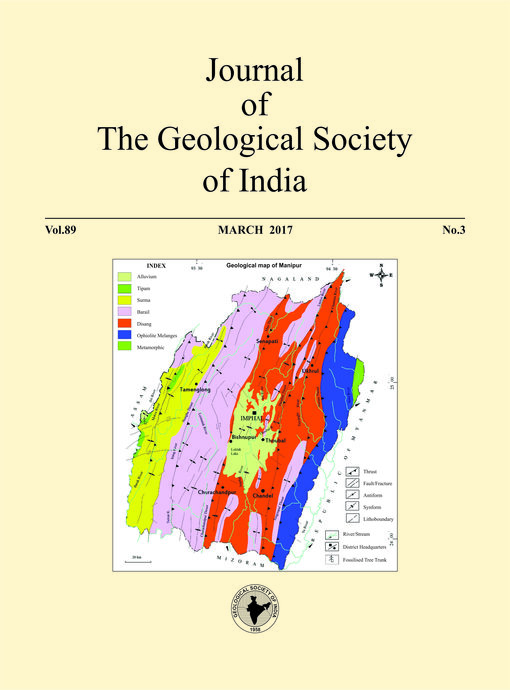Corbulid (Bivalvia) Species from the Palaeogene Mangrol Lignite Mine of Surat, Gujarat
DOI:
https://doi.org/10.1007/s12594-017-0605-zAbstract
Two corbulid species Caestocorbula gujaratensis var. mangroli and Caestocorbula gigantica are described here from the Mangrol Lignite Mine of Gujarat. Caestocorbula gigantica is the largest species within the corbulid clade. Detailed systematic description of the two species is the main stay of present endeavour. Since the two species have different overlapping morphologies, multivariate data analysis incorporating principal component analysis (PCA) and discriminant analysis (DA) have been applied in the present study. Application of PCA to test the variance among the morphometric data of the two species has been performed and the application of DA clearly separate the two species in spite of existence of correlation among the variables of two species.Downloads
Metrics
Issue
Section
Downloads
Published
How to Cite
References
Anderson, L.C. and Roopnarine, P.D. (2003) Evolution and phylogenetic relationships of Neogene Corbulidae (Bivalvia; Myoidea) of Tropical America. Jour. Paleontol., v.77, pp.1086–1102.
Bajpai, S., Kapur, V. V., Das, D. P., Tiwari, B. N., Sravanan, N. and Sharma, R. (2005a) Early Eocene land mammals from Vastan Lignite Mine, District Surat (Gujarat), western India. Jour. Palaeontol. Soc. India, v.50, pp.101-113.
Bajpai, S., Kapur, V.V., Thewissen, J.G.M., Tiwari, B.N. and Das, D.P. (2005b) First fossil marsupials from India: Early Eocene Indodelphis n. gen and Jaegeria n. gen. from Vastan Lignite Mine, district Surat, Gujarat. Jour. Palaeontol. Soc. India, v.50, pp.147-151.
Bajpai, S., Kapur, V.V., Thewissen, J.G.M., Tiwari, B.N., Das, D.P., Sharma, R. and Sravanan, N. (2005c) Early Eocene primates from Vastan lignite mine, Gujarat, western India. Jour. Palaeontol. Soc. India, v.50, pp.43-54.
Bajpai, S., Kapur, V.V., Thewissen, J.G.M., Das, D.P., Tiwari, B.N., Sravanan, N. and Sharma, R. (2006) New Early Eocene cambaythere (Perissodactyla, mammalian) from Vastan Lignite Mine District Surat (Gujarat), India and an evaluation of cambaythere relationship. Jour. Palaeontol. Soc. India, v.51, pp.101-110.
Bajpai, S., Kapur, V.V., Das, D.P. and Tiwari, B.N. (2007) New early Eocene Primates (Mammalia) from the Vastan Lignite Mine, District Surat (Gujarat), western India. Jour. Palaeontol. Soc. India, v.52, pp.231-234.
Bhandari, A. and Raju, D.S.N. (1991) Tertiary sea level changes and Transgression/Regression cycles in Cambay, Kutch and Rajasthan basin. A review. In: Pandey, J., Banerji, V., (Eds.), Proceedings of the Conference on Integrated and Exploratory Research. Achievements and Perspectives, pp.169-177. Dehradun.
Bhandari, A. (1998) Non-marine Ostracoda from the subsurface of the Cambay Shale (Eocene) of Gujarat, India and their paleoecological significance. Revista Española de Micropaleontologí¬a, v.30, pp.1-10.
Bhandari, A. (2003) Ostracod bio events in Tertiary beds of west coast of India. Gondwana Geol. Mag., v.6, pp.139-166.
Chandra, P.K. and Chowdhary, L.R. (1969) Stratigraphy of the Cambay Basin. Bull. ONGC, v.6, pp.37-50.
Etim, L., Sankare, Y., Brey, T. and Arntz, W.(1988) The dynamics of unexploited population of Corbula trigona (Bivalvia: Corbulidae) in a brackish-water lagoon, Cí´te d'Ivoire. Arch. Fish. Mar. Res., v.46(3), pp.253-262.
Garg, R., Ateequzzaman, K., Prasad, V., Tripathi, S.K.M., Singh, I.B., Jauhri, A.K. and Bajpai, S. (2008) Age-diagnostic dinoflagellate cysts from the lignite-bearing sediments of Vastan Lignite Mine, Surat District, Gujarat, western India, Jour. Palaeontol. Soc. India, v.53(1), pp.99-105.
Halder, K. and Bano, S. (2014) Cenozoic Corbulidae (Bivalvia, Mollusca) from the Indian subcontinent-palaeobiogeography and revision of three species from Kutch, India, Arabian Jour. Geosci., Springer, DOI 10.1007/ s12517-014-1362-6.
Hammer, í˜. Harper, D. and Ryan, P.D. (2001) PAST: Paleontological Statistic Software Package for education and data analysis. Paleontological Association (Computer software).
Hotteling, H. (1933) Analysis of a complex of statistical variables into principal components. Jour. Education Psychology, v.24, pp.417-41, 498-520.
Iredale, T. (1930) More notes on the marine Mollusca of New South Wales. Records of the Australian Museum 17(9):384-407, pls.62-65.
Jackson, J.E. (1991) A User's Guide To Principal Components. John Willey & Sons Inc., New York, 570p.
Jeffery, P. and Tracey, S. (1997) The Early Eocene London Clay Formation mollusc fauna of the former Bursledon Brickworks, Lower Swanwick, Hampshire, Tertiary Research, v.17, pp.75-137.
Jolliffe, I.T. (2002) Principal Component Analysis, 2nd Edition. Springer. 487p.
Maslin, J.L. and Bouvet, Y. (1988) Métabolisme respiratoire de Corbula trigona (Mollusues: Pélécypodes) d'une lagune du sud Bénin. Rev. Hydrobiol. Trop. v.21, pp.8-19.
Rana, R.S., Kumar, K. and Singh, H. (2004) Vertebrate fauna from the subsurface Cambay Shale (Lower Eocene), Vastan Lignite, Gujarat India. Curr. Sci., v.87, pp.1726-1733.
Rana, R.S., Singh, H., Sahni A., Rose, K.D. and Saraswati, P.K. (2005) Early Eocene chiropterans from a new mammalian assemblage (Vastan Lignite Mine, Gujarat, western Peninsular Margin): oldest known bats from Asia. Jour. Palaeontol. Soc. India, v.50, pp.93-100.
Rao, M. R., Sahni, A., Rana, R.S. and Verma, P. (2013) Palynostratigraphy and depositional environment of Vastan Lignite Mine (Early Eocene), Gujarat, western India. Jour. Earth Syst. Sci., v.122 (2), pp.289-307.
Reyment, R.A. and Jöreskog, K.G. (1996) Applied Factor Analysis in the Natural Sciences. Cambridge University Press, Cambridge, UK, 371p.
Rose, K. D., Smith T., Rana, R. S., Sahni, A., Singh, H., Miassiaen, P. and Folie, A. (2006) Early Eocene (Ypresian) continental vertebrate assemblage from India, with description of a new Anthracobunid (Mammalia, Tethytheria). Jour. verte. Paleontol., v.26, pp.219-225.
Sahni, A., Saraswati, P.K., Rana, R.S., Kumar, K., Singh, H., Alimohammadian, H., Sahni, N., Rose, K.D., Singh, L. and Smith, T. (2006) Temporal Constraints and Depositional Palaeoenvironments of the Vastan Lignite Sequence, Gujarat: Analogy for the Cambay Shale hydrocarbon source rock. Ind. J. Petroleum Geol., v.15, pp.1–20.
Smith, T., Rana, R.S., Missiaen P., Rose, K.D., Sahni, A., Singh, U. and Singh, L. (2007) High bat (Chiroptera) diversity in the early Eocene of India. Naturwissenchaften, v.99, pp.1003-1009.
Sudhakar, R. and Basu, D.N. (1973) A reappraisal of the Palaeogene stratigraphy of southern Cambay Basin. Bull. ONGC, v.10, pp.55-76.
Tripathi, S.K.M. and Srivastava, D. (2012) Palynology and palynofacies of the early Palaeogene lignite bearing succession of Vastan, Cambay Basin, western India. Acta Palaeobotanica, v.52, pp.157-175.

 Pinaki Roy
Pinaki Roy






